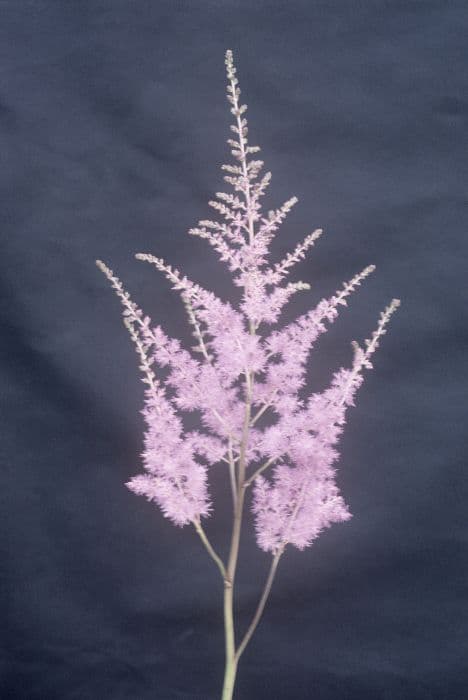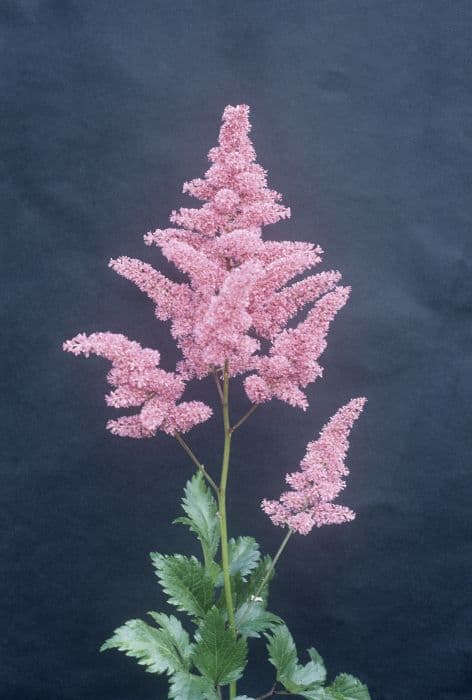Coral Bells Heuchera 'Molly Bush'

ABOUT
Heuchera 'Molly Bush', commonly known as Coral Bells, features a striking appearance that makes it a favorite among garden enthusiasts. The plant is characterized by its lush foliage, which tends to have a rich texture and can display a variety of colors based on the specific cultivar. The leaves of 'Molly Bush' are often rounded, with lobed edges that may appear scalloped or ruffled, providing a full and somewhat mounded look. The leaves exhibit a vibrant hue, ranging from deep purples to rich greens, often with veining or marbling in contrasting colors that enhance their visual appeal. Depending on light exposure, the colors can intensify, adding to the plant's ornamental value. Coral Bells bloom in the warmer months, producing delicate bell-shaped flowers that hang in loose clusters on slender stems. These flowers can be white, pink, red, or coral, complementing the foliage beautifully. The flowering stems rise above the mound of leaves, creating an airy and whimsical effect that can add height and texture contrasts to garden compositions. The combination of attractive foliage and charming flowers allows Coral Bells to serve both as a colorful groundcover and as a striking feature in rock gardens, borders, or container arrangements. Its foliage often remains attractive throughout the growing season, contributing lasting interest to the garden.
About this plant
 Names
NamesSynonyms
Coral Bells, Alumroot
Common names
Heuchera 'Molly Bush'.
 Toxicity
ToxicityTo humans
Heuchera, commonly known as coral bells, is not typically considered toxic to humans. There is no widespread evidence or documented cases that suggest the consumption of Heuchera 'Molly Bush' would cause poisoning or adverse health effects to humans. Always exercise caution and avoid ingesting plants not meant for consumption to prevent potential allergic reactions or unforeseen toxicities.
To pets
Coral bells are generally considered non-toxic to pets. Therefore, Heuchera 'Molly Bush' is unlikely to cause poisoning if ingested by pets such as cats or dogs. However, it's always advisable to monitor pets around plants, as individual animals may have unique sensitivities or allergic reactions to plant material that are atypical.
 Characteristics
CharacteristicsLife cycle
Perennials
Foliage type
Semi-deciduous
Color of leaves
Varies
Height
1 foot (30 cm)
Spread
1 foot (30 cm)
Plant type
Herb
Hardiness zones
4
Native area
North America
Benefits
 General Benefits
General Benefits- Attractive foliage: Heuchera 'Molly Bush', commonly known as Coral Bells, has colorful leaves that add visual interest to gardens.
- Long blooming period: The plant produces delicate bell-shaped flowers that bloom for an extended period, providing long-lasting garden appeal.
- Low maintenance: Coral Bells are known for being easy to care for and requiring minimal upkeep once established.
- Drought tolerance: Once established, they can tolerate periods of dryness, making them suitable for water-wise gardens.
- Pest resistance: They are generally resistant to common garden pests.
- Attracts pollinators: The flowers of Coral Bells attract butterflies and hummingbirds, promoting biodiversity in the garden.
- Versatility: These plants can thrive in a range of conditions from full sun to shade and can be used in various garden designs.
- Seasonal interest: Coral Bells offer year-round interest with seasonal foliage changes and persistent leaf presence in mild winters.
 Medical Properties
Medical PropertiesThis plant is not used for medical purposes.
 Air-purifying Qualities
Air-purifying QualitiesThis plant is not specifically known for air purifying qualities.
 Other Uses
Other Uses- Container Gardening: Heuchera 'Molly Bush', commonly known as Coral Bells, is compact and offers attractive foliage that can add color and texture to container plantings.
- Edging Pathways: The mounding habit of Coral Bells makes them suitable for edging along paths and walkways, creating a defined border with their foliage.
- Underplanting for Roses: Coral Bells can be used to underplant roses, providing a contrast in texture and helping to cover bare stems at the base of the rose bushes.
- Accentuating Sculptures: The plant's interesting foliage can make a fascinating backdrop for garden sculptures or art, accentuating their features.
- Livestock Forage: While not a common use, the leaves of Coral Bells could potentially be used as occasional forage for livestock like rabbits and deer in a pinch.
- Moss Garden Companion: Coral Bells can be integrated into moss gardens where their textured leaves complement the smooth carpet of mosses.
- Fairy Gardens: The small and intricate foliage of Coral Bells makes them suitable for inclusion in miniature fairy gardens.
- Culinary Garnish: In some instances, the flowers of Coral Bells, while not commonly consumed, can be used as a decorative garnish for salads and desserts.
- Photography Backdrops: The foliage of Coral Bells can provide a natural and colorful backdrop for close-up photography of insects and other small wildlife.
- Terrariums: Although they are typically outdoor plants, Coral Bells can be used in large terrariums, adding a variety of texture and color.
Interesting Facts
 Feng Shui
Feng ShuiThe Coral Bells is not used in Feng Shui practice.
 Zodiac Sign Compitability
Zodiac Sign CompitabilityThe Coral Bells is not used in astrology practice.
 Plant Symbolism
Plant Symbolism- Durability: Heuchera, commonly known as Coral Bells, is known for its resilience and tolerance of various growing conditions, symbolizing endurance and robustness.
- Variety: With a wide range of leaf colors and textures, Coral Bells represent diversity and variety, mirroring the beauty of difference in the world.
- Attractiveness: The showy nature of the flowers and foliage of Coral Bells makes them a symbol of attraction and charm, often used to enhance garden aesthetics.
- Balancing Contrast: The contrast between the delicate flowers and the bold foliage of the Coral Bells can symbolize the balance between different elements, reminding us of the harmony in diversity.
 Water
WaterCoral Bells should be watered regularly, aiming for about 1 inch of water per week, depending on weather conditions. It's important to ensure that the soil is well-draining and moist, but never waterlogged. During the hotter, drier months, you may need to water once or twice a week, providing approximately 0.5 to 0.75 gallons each time to maintain consistent soil moisture. In cooler, wetter weather, watering frequency should be reduced to prevent overwatering. Always check the top inch of the soil before watering; if it's dry, it's time to water the plant.
 Light
LightCoral Bells thrive best in conditions where they can receive partial shade to full shade. The ideal spot for planting is where they can be protected from the harsh afternoon sun but can still receive filtered morning light or dappled shade throughout the day. They can tolerate some morning sun, but too much direct sunlight can lead to leaf scorch.
 Temperature
TemperatureCoral Bells are adaptable to a range of temperatures but perform best when the temperature is between 60 and 70 degrees Fahrenheit. They can survive minimum temperatures down to around 20 degrees Fahrenheit but should be protected from extreme cold. Ideally, maintain the plant in an environment that stays within this temperature range to ensure healthy growth.
 Pruning
PruningPruning Coral Bells is necessary to remove dead or damaged foliage and to encourage a fuller, more attractive shape. This should be done in early spring or late winter before new growth begins. Cut back any old, tattered leaves to the ground, and snip off flower stalks after blooming to tidy up the plant. Pruning can be performed once a year or as needed to maintain a neat appearance.
 Cleaning
CleaningAs needed
 Soil
SoilCoral Bells, commonly referred to as Heuchera 'Molly Bush', thrive best in a soil mix that is well-draining and rich in organic matter. A mix of one part garden soil, one part peat moss or coconut coir, and one part perlite or sand can create an ideal environment for root growth. It's important for the soil pH to be slightly acidic to neutral, ranging from 6.0 to 7.0.
 Repotting
RepottingCoral Bells typically require repotting every 2-3 years. As they are slow-growing, Heuchera 'Molly Bush' should be repotted when the root system outgrows the current container or to refresh the soil and provide new nutrients.
 Humidity & Misting
Humidity & MistingCoral Bells prefer moderate humidity levels and can thrive in the average home humidity. They do well with the humidity level between 40% and 50%.
 Suitable locations
Suitable locationsIndoor
Place Coral Bells in bright, indirect light and keep the soil moist.
Outdoor
Plant Coral Bells in partial shade and well-draining soil.
Hardiness zone
4-9 USDA.
 Life cycle
Life cycleCoral Bells 'Molly Bush' begins its life as a seed which, when sown, will germinate under the right conditions of warmth and moisture. The seedling stage follows, with the emergence of the first true leaves, establishing the baby plant. As it enters the vegetative stage, it develops a rosette of leaves and a robust root system. The plant then reaches maturity and enters the flowering stage, producing tall, slender stalks with bell-shaped flowers that can attract pollinators. After pollination, the flowers will develop into seed pods, completing the cycle as these seeds are dispersed for future germination. Coral Bells 'Molly Bush' is a perennial, and after flowering, it can go into dormancy during colder months to re-emerge in the spring.
 Propogation
PropogationPropogation time
Spring-Early Summer
Propogation: The most popular method of propagation for Heuchera 'Molly Bush', commonly known as Coral Bells, is by division. This process is best done in spring or fall when the plant is not in full bloom. To propagate by division, carefully dig up the entire plant and gently separate the clumps into smaller sections, each with a portion of the root system. It's important to ensure that each new section has at least a few shoots or leaves to enable it to establish itself when replanted. After dividing, replant the sections at the same depth they were originally growing and water them thoroughly. With proper care, these new plants will establish themselves and grow to replicate the beauty of the original Coral Bells.









